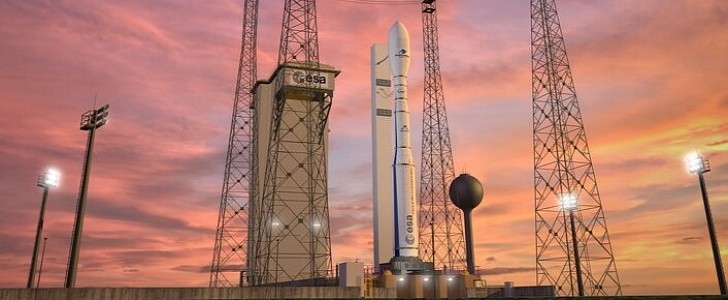Europe is determined to play a leading role in the accelerated space economy, and in order to do so, it needs cutting-edge launch vehicles powered by equally-advanced engines. A versatile and efficient motor, the P120C developed on behalf of ESA (the European Space Agency) has entered production.
The P120C rocket motor represents a milestone for the European space industry as a whole because of its pioneering versatility – it can be used for two launch vehicles that are very similar. Both the Ariane 6 and the Vega-C, soon to start operating from the European spaceport in French Guyana, will benefit from the qualities of this new propulsion system.
Developed by Europropulsion, a company that’s jointly owned by Avio in Italy and ArianeGroup in France, the P120C is the result of multiple partners working together on this challenging project. The engine’s monolithic casing was made by Avio, based on carbon composite. Its advanced nozzle was made by ArianeGroup, and the igniter was provided by the Norwegian company Nammo. According to ESA, advanced manufacturing methods also played a part in delivering the P120C faster, with fewer costs.
The new motor is 13.5-meter-long (44 feet), with a diameter of 3.4 meters (11 feet), boasting a casing that’s 25 cm-thick (9.8”). It’s designed to deliver a liftoff thrust of approximately 4,500 kN (458.8 tf), using 142 tons of fuel. It will be used as the first stage of the Vega-C rocket, and two or four of them will be used as strap-on boosters for the Ariane 6 rocket. Due to this ability to operate with both types of rockets, ESA describes it as its “new solid propulsion workhorse.”
Two years ago, the first stage P120C, the second-stage Zefiro-40, and the third stage Zefiro-9 of the Vega-C successfully completed hot-fire tests. Thanks to these motors, the Vega-C is expected to deliver payloads of up to 2,300 kg (5,000 lbs) at 700 km (435 miles) altitude in polar orbit.
Additionally, ESA is already planning an advanced version of this motor, the P120C+, which will increase payload capacity for the rockets and extend their mission range.
Developed by Europropulsion, a company that’s jointly owned by Avio in Italy and ArianeGroup in France, the P120C is the result of multiple partners working together on this challenging project. The engine’s monolithic casing was made by Avio, based on carbon composite. Its advanced nozzle was made by ArianeGroup, and the igniter was provided by the Norwegian company Nammo. According to ESA, advanced manufacturing methods also played a part in delivering the P120C faster, with fewer costs.
The new motor is 13.5-meter-long (44 feet), with a diameter of 3.4 meters (11 feet), boasting a casing that’s 25 cm-thick (9.8”). It’s designed to deliver a liftoff thrust of approximately 4,500 kN (458.8 tf), using 142 tons of fuel. It will be used as the first stage of the Vega-C rocket, and two or four of them will be used as strap-on boosters for the Ariane 6 rocket. Due to this ability to operate with both types of rockets, ESA describes it as its “new solid propulsion workhorse.”
Two years ago, the first stage P120C, the second-stage Zefiro-40, and the third stage Zefiro-9 of the Vega-C successfully completed hot-fire tests. Thanks to these motors, the Vega-C is expected to deliver payloads of up to 2,300 kg (5,000 lbs) at 700 km (435 miles) altitude in polar orbit.
Additionally, ESA is already planning an advanced version of this motor, the P120C+, which will increase payload capacity for the rockets and extend their mission range.







